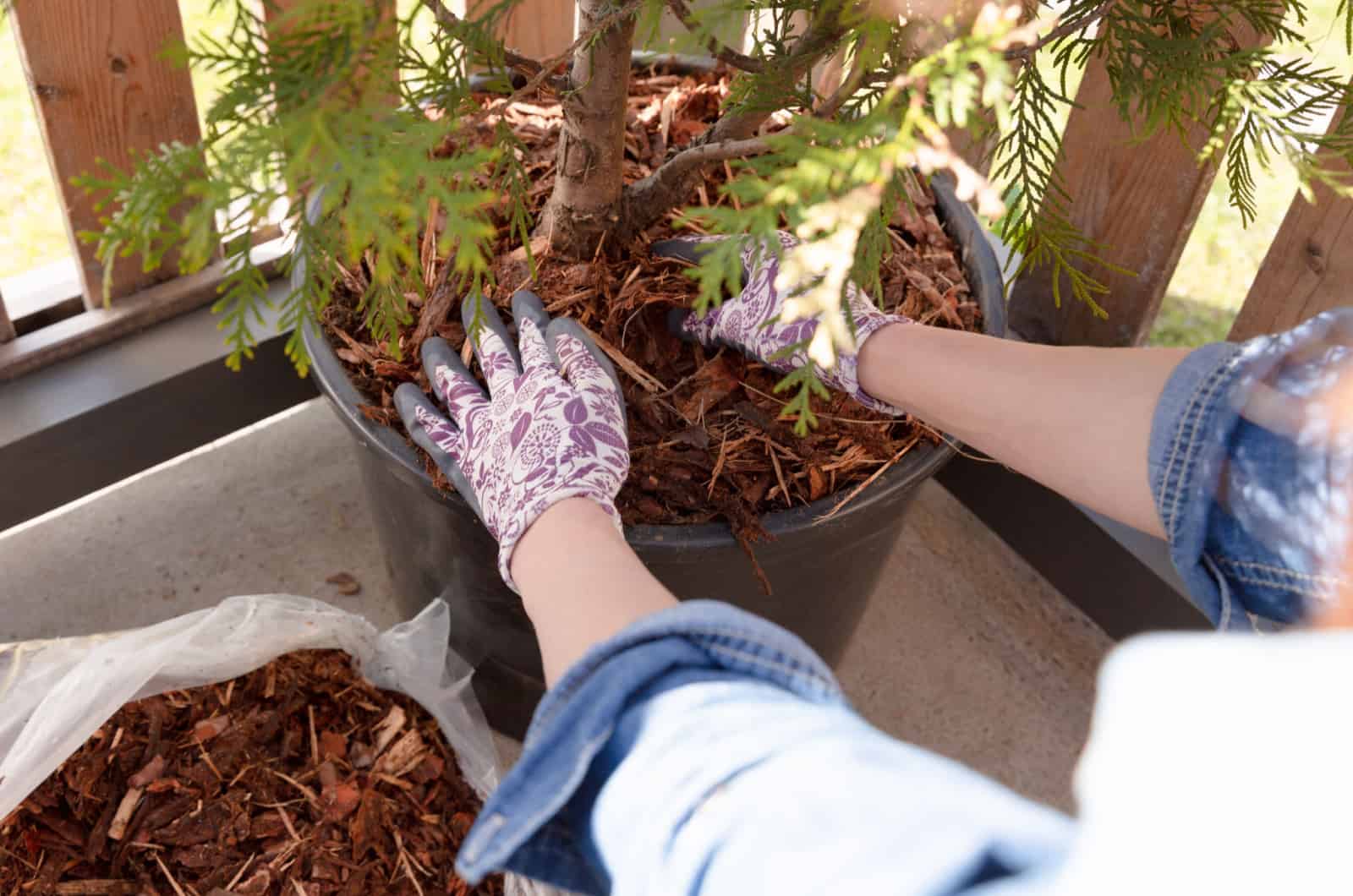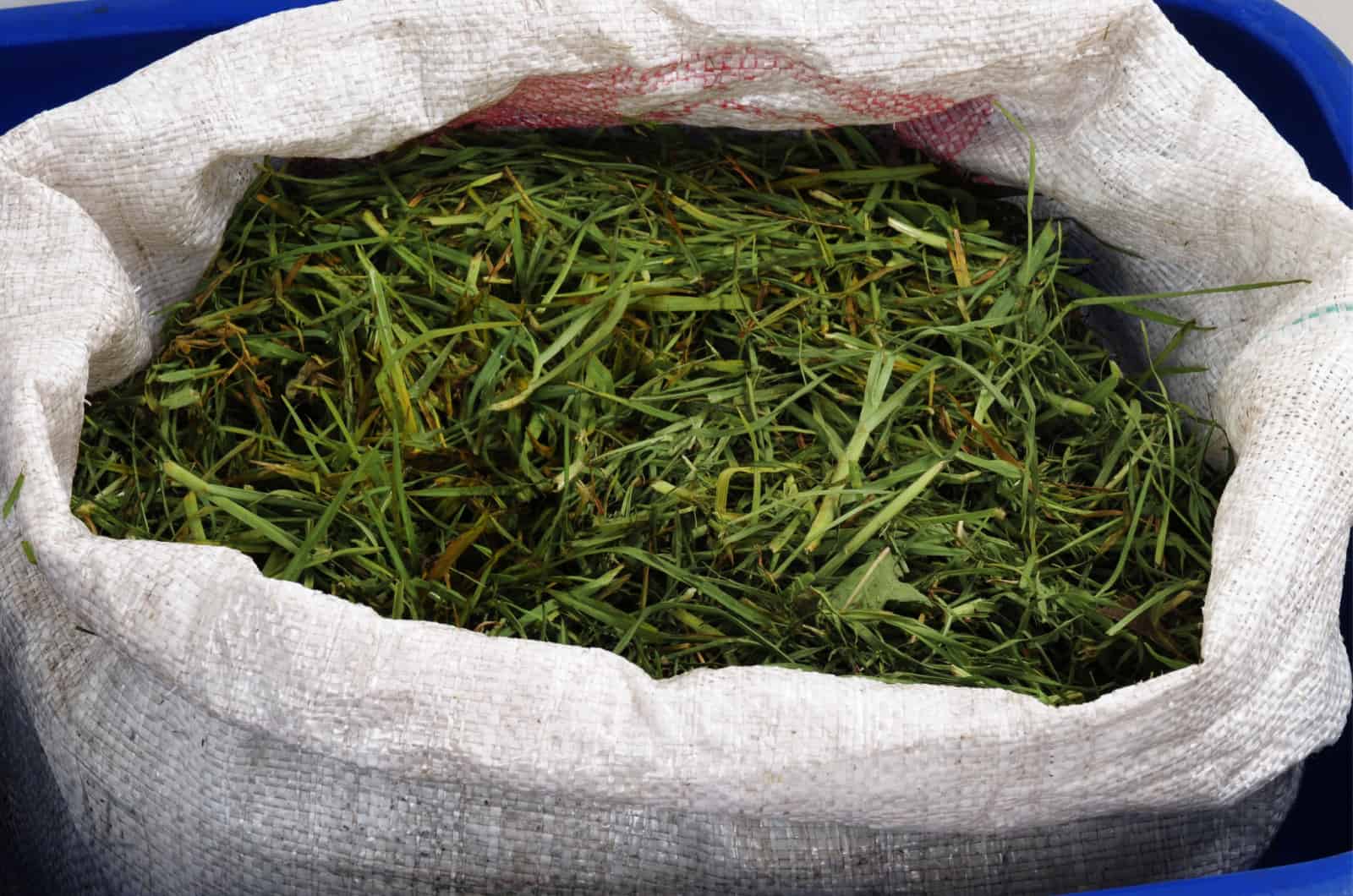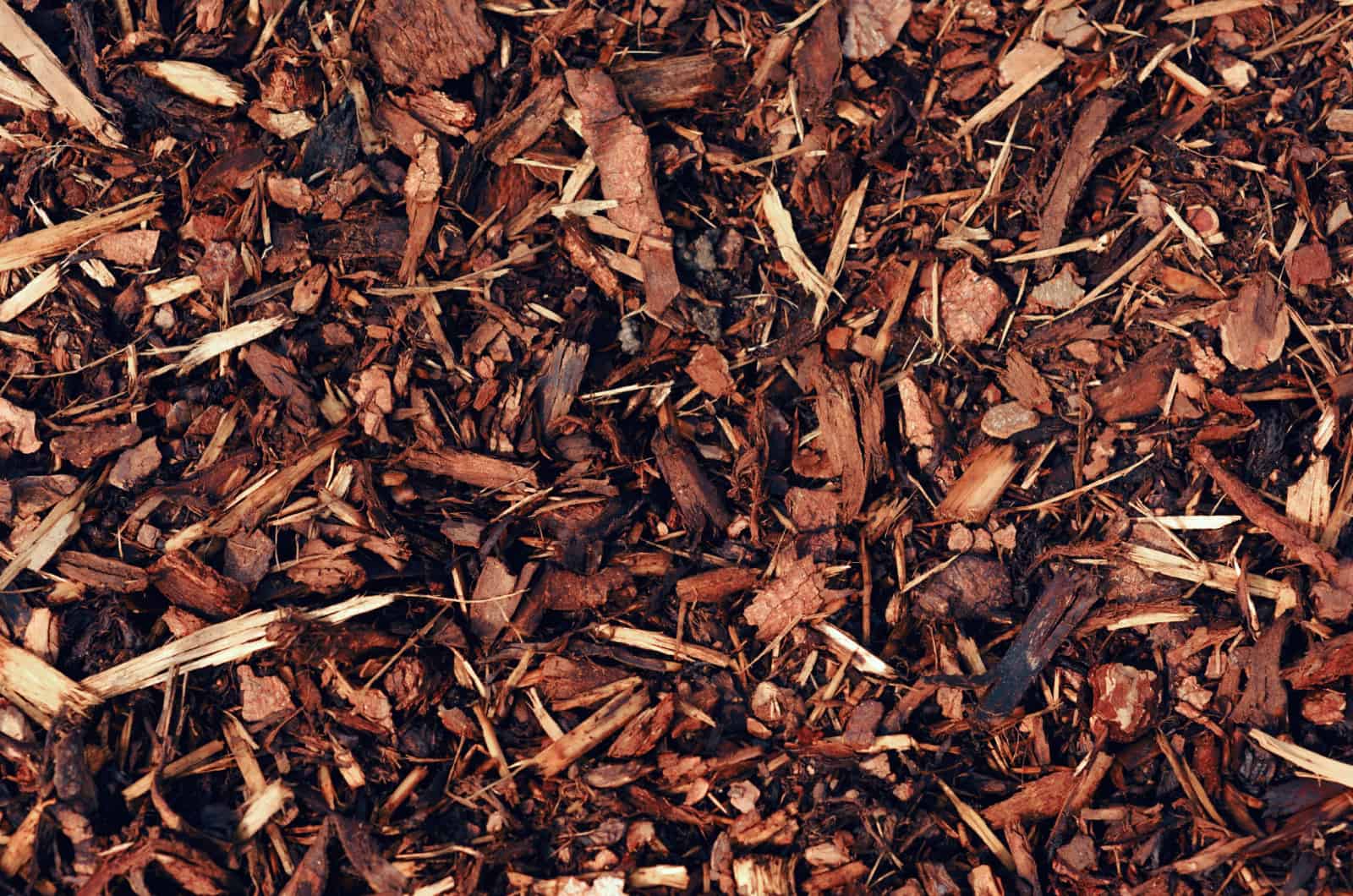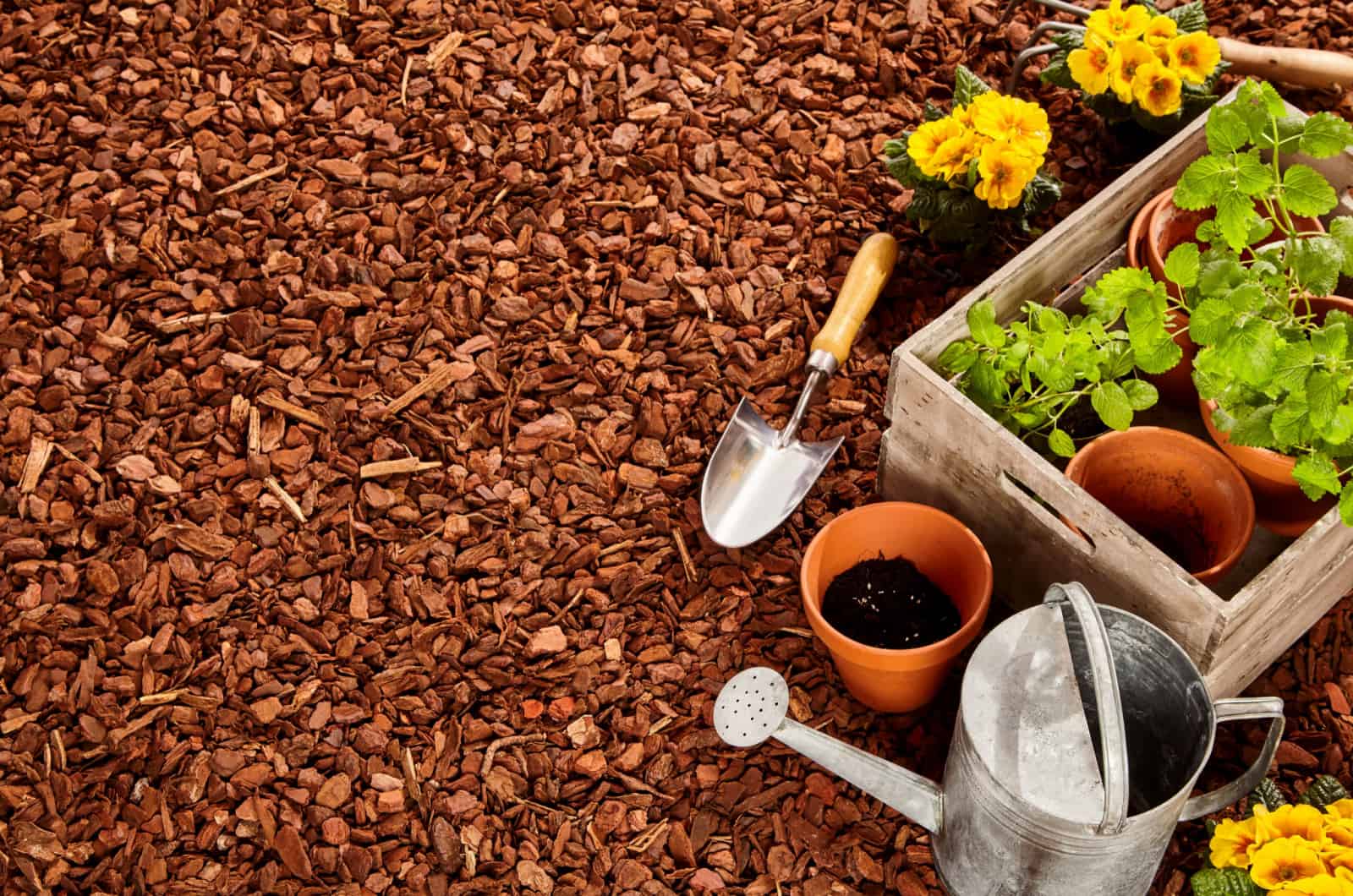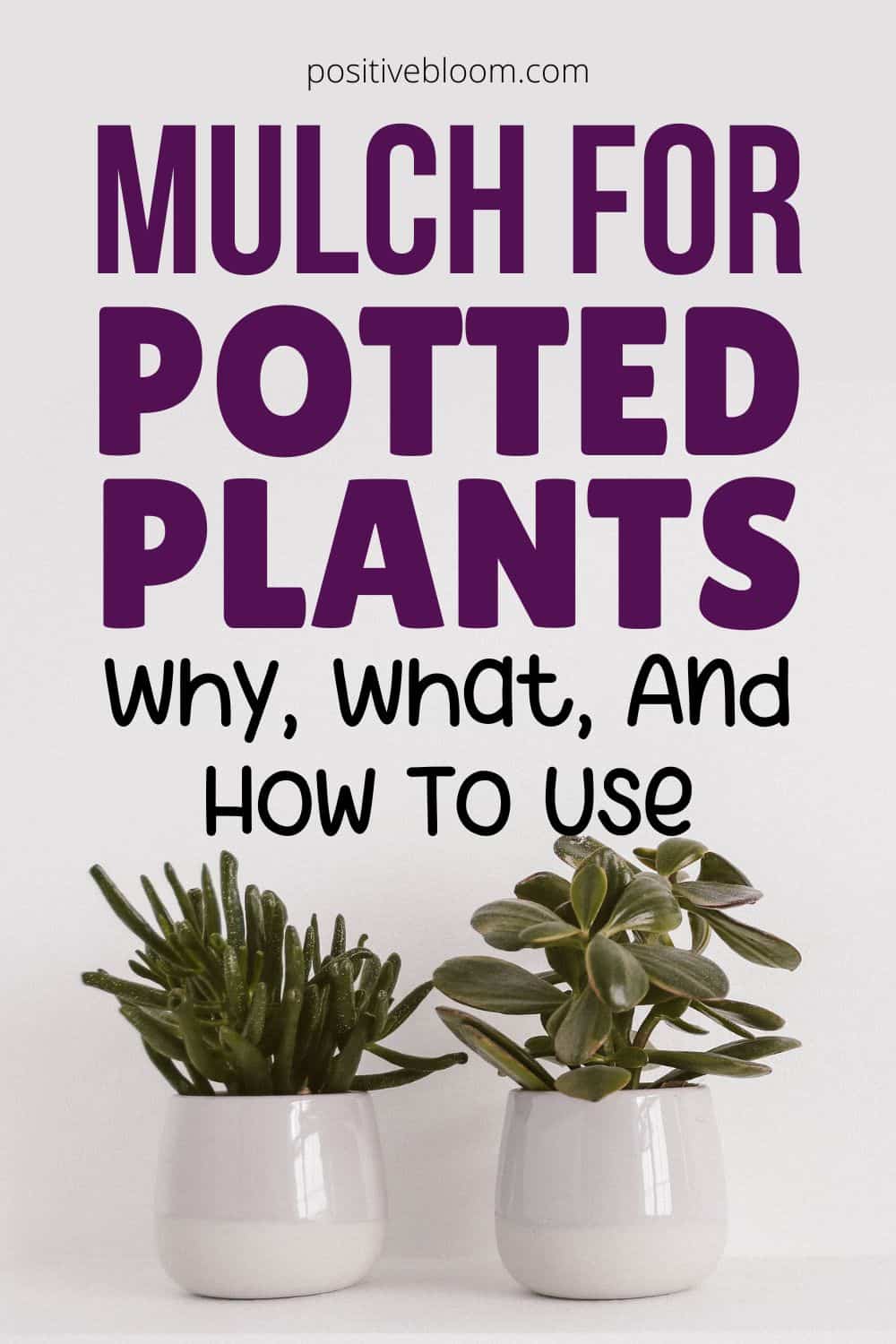Positive Bloom is an Amazon Associate and we earn from qualifying purchases through these links at no extra cost to you.
Mulching your soil has many benefits, such as keeping your plant’s roots hydrated and safe from the scorching sun. But, is it possible to have all these (and many more) advantages transferred onto your container plants?
In a word: yes!
This article will bring you all the ins and outs of using mulch for potted plants. The main questions we’ll tackle are why you should use it, what to use as mulch, and how to use it.
However, those are not the only important questions regarding this topic. You need to be aware of other things when mulching your plants, such as how to water mulched plants, if you ever need to remove the mulch, and more.
Now, let’s begin!
Should You Use Mulch For Potted Plants?
One of the most important questions about mulching potted plants is whether you should do it in the first place.
Well, you can always choose for yourself, but there are a lot of benefits to adding a layer of mulch to your container plants.
For instance, it regulates the soil temperature for longer and reduces water loss, so you won’t have to water your plants as often. Mulch can also prevent weed growth, and you can forget about spending all of your free time weeding undesirable plants.
Therefore, mulching can take a lot of work off your plate, but it is optional, and you don’t have to do it if you don’t like the look of it or don’t mind putting in extra work instead.
However, we’ll still examine the main benefits in more detail in the sections below.
Benefits Of Mulch For Container Gardening
The following sections examine several advantages of using mulch for container gardening, such as moisture retention, soil temperature regulation, plant protection, preventing weed growth, and increasing the organic content in the substrate.
Oh, and yes, it will also improve the overall appearance of your plant!
But we’ll talk more about that in a minute.
Soil Moisture Regulation
Water retention is one of the main benefits of mulching all plants, not just container ones. Mulch reduces the evaporation of water from the soil by 50%, so you won’t have to irrigate your plants as often.
This method can also reduce the risk of underwatering your plants, and they won’t be stressed out, drooping, curly, etc.
So, the benefit here is doubled: the watering chores are reduced, and your plants will be healthy and moisturized for longer.
Soil Temperature Regulation
Plants’ roots are sensitive to temperature fluctuations and dislike heat and cold. Unfortunately, potting soil is usually not enough to protect them in extreme temperatures, so you should turn to mulch.
Adding a layer of pine bark or some other kind of mulch onto the topsoil can slow down the temperature changes in the soil and prevent your plants from becoming unwell or even dying.
Plant Protection
Keeping the plants protected doesn’t only refer to keeping them away from the wind and harsh midday sun (although that is a great start).
Mulching the soil surface can get you a long way and protect your green buddies even more.
For instance, it is not strange to find gnats, spider eggs in the soil, or other pests trying to colonize your plant, and if you want to prevent them from getting into the growing medium in the first place, you can simply mulch your plant and be done with it.
Another common thing that happens frequently is our pets digging into the plant’s soil. However, mulching the substrate (especially with a material your pets won’t like to touch) is an excellent way to repel your furry friends and protect your plants.
Mulch can also prevent your plants from catching certain diseases. Of course, mulch isn’t a disease-repellent, but it can stop water from splashing onto your plant’s leaves and reduce the risk of certain fungal infections, such as leaf spot and powdery mildew.
Finally, mulch will act as another protective layer that keeps your plant’s roots safe from the sun and drying out.
Weed Growth Prevention
One of my favorite benefits of mulching both indoor and outdoor plants is weed growth prevention, or rather, inhibiting the germination of weed seeds that uptake water and nutrients and leave your plant both thirsty and hungry.
Of course, there are ways to fight the weeds, such as removing them by hand or spraying them with herbicides, but these methods are time-consuming and not organic.
It is better not to have to do it in the first place, and mulching can help you with that.
Organic Matter Increase
Using organic mulch can increase the number of nutrients and organic content in the soil as it decomposes. Your plants will use the minerals for further growth, and you won’t have to fertilize them too often.
But using organic mulch doesn’t only introduce new organic matter into the soil; it also contains beneficial microorganisms that improve moisture retention and aeration.
Improves Aesthetics
One thing I love about mulching (in addition to all the above-mentioned ones) is that it improves the appearance of your plant tremendously.
Potting mixes aren’t always attractive, and if you want your plant to fit into your modern, minimalistic aesthetic design, you can always mulch it with some bark, wood chips, or even some decorative stones and gravel.
Just imagine, we’ve finally found a way to keep our plants happy and pretty at the same time!
What To Use As Mulch For Potted Plants
“Mulch your indoor plants!” is a gardening tip I got from an old friend, but I did wonder which mulch I should use.
Unfortunately (or luckily) for all of us, there are many different mulch types we can work with. Although, they are usually categorized into two groups: organic and inorganic mulch.
We’ll discuss the benefits and drawbacks of each so that you can decide which one is the right choice for your container plants (or flower beds).
Organic Mulch
Organic mulch is made from those materials that decompose and enrich the soil with nutrients and organic content.
There is a wide range of materials you can use as organic mulch, but we’ll stick to the basics.
Grass Clippings
There are many pros and cons of using grass clippings as mulch, but one of my favorite benefits is that you won’t have to feed your plants that often (or at all) if you add a layer of this material onto the soil surface.
Grass clippings are extremely rich in nitrogen (although they do contain phosphorus and potassium in smaller amounts), so your green houseplants can benefit from this mulch type.
They can also improve the soil texture as they decompose, help regulate soil temperature, etc.
However, they may not be the best way to prevent weed growth since they can contain seeds just waiting to germinate.
Also, you shouldn’t use grass clippings if you have sprayed them with pesticides or used synthetic fertilizers, as they may contain a residue of these chemicals and hurt your plants.
Pine Needles
Mulching plants with pine needles is an excellent choice since they don’t decompose as fast as other types, such as grass clippings or leaves.
They will keep the soil aerated and protect your plant’s root system from constant temperature fluctuations.
Pine needles contain nitrogen, phosphorus, and calcium—minerals from which your plants greatly benefit.
Also, they are available year-round, and you can even gather them in winter to help keep your plants warm.
They can prevent weed growth to a certain degree, but they are not the best option. And always use needles that have dried out beforehand.
Fresh and moist pine needles may rot quickly or lead to mold appearing on the soil surface.
Wood Chips
We’ve all heard about wood chip mulch and how great it is to use around the garden. But we shouldn’t forget that there are both advantages and disadvantages to using wood chips and bark mulch (but you can read more about bark in the next section).
Wood chips decompose slowly and can last up to five years, making them a preferred choice for slow-growing plants that don’t require frequent repotting.
They enrich the soil with organic matter and make a DIY project look like it’s been done professionally.
You should always use dry wood chips that don’t contain any fungus spores, or they may rot and infect your plants.
Also, this material may start producing toxic chemicals and leeching them into the soil, so replace them every once in a while to keep your plants healthy.
I know this goes without saying, but don’t expose your potted plants to harsh winds. Yes, there may be some wind damage and dry air, but you can also wake up one day to find your wood chips gone from the container.
Bark Mulch
Bark mulch is similar to wood chips, but it’s not the same. The bark is the outer part of the tree and rougher when compared to soft wood chips.
Pine bark is the most famous one, but spruce and fir bark are also excellent choices for mulching your potted plants.
Bark lasts longer than other organic materials used for mulch, which is why most growers prefer using it.
This material can also retain moisture (even better than wood chips), enriches the soil with organic content, and prevents weed growth.
The bark does contain certain doses of nitrogen, but that number is not particularly high, so you will have to fertilize your plants from time to time.
Finally, this material isn’t that heavy, so it could get blown or washed away if you leave your plant outside.
Leaf Mulch
One of the things I like about mulching is that you usually don’t need to go too far from your garden to get everything you need.
For instance, you can use old leaves instead of burning them or throwing them into the trash. However, you should ensure that they are completely dry and then shred them before covering the soil surface around your plant.
When leaves start decomposing, they enrich the soil with nutrients, so you won’t have to feed your plants very often.
Also, they help regulate the soil temperature and will keep your plant cool in the summer and warm in winter.
Dried leaves can even keep slugs and other similar pests at bay, so they’re a fantastic choice for outdoor plants as well.
Compost
We usually use compost as a soil amendment before planting, but did you know that you can also mulch your plants with it?
Of course, if you don’t have your own, you might wonder how long it takes to make compost in the first place. The good news is that it is ready to use in about three months, and you won’t have to spend money on expensive mulch or soil amendments.
It adds organic content and nutrients to the soil and even introduces beneficial organisms that make the growing substrate more aerated.
Compost also increases water retention and prevents your plant’s roots from drying out when temperatures are scorching.
However, compost is a decomposing matter by definition, and it will degrade sooner than some other materials. It isn’t the best way to prevent weed growth unless you apply a thick layer (but that may be counterproductive for potted plants).
Inorganic Mulch
Inorganic mulch also has its benefits, and even though it doesn’t enrich the soil with organic content, it can still keep your plant warm, retain moisture, and prevent pest attacks and weed growth.
It is also longer lasting than most organic mulches (and some materials may last forever).
The most popular inorganic mulch for container plants is made from small rocks, stones, and even ornamental gravel and pebbles. Rubber mulch is becoming more and more popular, too, as you can get it in different shades and colors.
Of course, landscaping fabric and plastic sheeting are unavoidable, but they are usually only used in outdoor gardening, not for potted plants.
Since these materials don’t contain any nutrients, they all have the same function. They slow down the evaporation rate and temperature fluctuations, prevent weed growth, prevent water splashing onto your plant’s leaves, etc.
7 Best Types Of Mulch For Potted Plants
There isn’t such a thing as the best mulch for all plants since different varieties have different requirements.
But there are certain products that we love and trust!
We picked our seven favorite mulch types for potted plants, all of which can protect your plants and meet your aesthetic requirements.
1. Envelor Coco Coir Chips
[lasso id=”10430″ link_id=”11017″ ref=”amzn-or-coco-coir-chips-orchid-potting-mix-10-lb-brick-mulch-potting-soil-indoor-plant-planting-chips-coconut-fiber-substrate-orchid-bark-growing-media-coir-husk-chips-compressed-coconut-coir-2-pack”]
Coco coir is an excellent material that can be used to amend soil or mulch your plants. This product is perfect for indoor and outdoor plants and contains no harmful chemicals.
Coir comes in blocks that can expand up to 18 times its size after adding warm water.
Since these coco chips improve aeration and drainage, they ensure proper root growth and plant development.
However, this material also contains water-retentive abilities, so you won’t have to irrigate your plants frequently.
It saves you time and energy that you can then spend relaxing or admiring your healthy indoor garden.
2. Mosser Lee Spanish Moss
[lasso id=”10436″ link_id=”11018″ ref=”amzn-supermoss-26914-spanish-moss-preserved-natural-8oz-200-cubic-inch”]
Spreading Spanish moss around your plants is an excellent and eco-friendly way of decreasing water loss.
You can even grow this plant on your own, as the care guide for Spanish moss isn’t that demanding. It needs bright light, high humidity, and mild temperatures to thrive.
It is renewable and natural, so you won’t harm the environment. But mulching is not the only way you can use this material. It is a popular decoration piece in many artificial arrangements, terrariums, baskets, pots, etc.
It is also very easy to use; you just need to spread it over the surface, and you’re done.
Finally, it preserves soil moisture and doesn’t interfere with feeding and watering, so you don’t have to think of creative ways to meet your plant’s moisture and nutrient needs.
3. OUPENG Pebbles Polished Gravel
[lasso id=”10431″ link_id=”11019″ ref=”amzn-oupeng-pebbles-polished-gravel-natural-polished-mixed-color-stones-small-decorative-river-rock-stones-2-pounds-32-oz”]
These pebbles, gathered from the river, have been polished for a shinier and smoother effect. The polish also makes their color long-lasting, so you won’t have to change them frequently.
These river rocks increase water drainage if mixed into the soil or improve the appearance of your plants if used for mulch.
This particular product has many functions and can be used in crafts, decorations, and aquariums, or for mulching, increasing drainage, and many other uses.
You can even walk on it since it has no sharp edges and won’t hurt your feet. You can also use it indoors and outdoors, and paraffin wax enhances its color and increases its shine.
Finally, since this is natural river rock, it comes in different shapes and sizes, as well as colors, so your decor won’t be monotonous.
4. Playsafer Rubber Mulch Nuggets
[lasso id=”10432″ link_id=”11020″ ref=”amzn-playsafer-rubber-mulch-nuggets-protective-flooring-for-playgrounds-swing-sets-play-areas-and-landscaping-40-lbs-1-55-cu-ft-red”]
This inorganic material is ideal for mulching your plants as it prevents weed growth while at the same time letting in water and fertilizers.
However, you can also use it for landscaping designs, terrariums, playgrounds, etc. It doesn’t attract or breed termites, nor does it decompose, which makes it a highly desirable (durable) material.
It is safe for children and plants, and it spreads rather easily.
This material is perfect for those who want to help nature as it is made from recycled rubber and contains almost no metals (99.9% metal-free is a good percentage, I’d say). Also, you can use it for many years to come, but the color will start to fade after some time.
Finally, these rubber nuggets dry out very quickly and won’t freeze in winter, so they can keep your plants safe and healthy even in more extreme conditions.
5. TOYPOPOR Orchid Potting Bark
[lasso id=”10433″ link_id=”11021″ ref=”amzn-orchid-potting-bark-2-qt-all-natural-pine-wood-chips-houseplant-mulch-for-proper-root-development-on-all-orchid-plant-types-3-8-size”]
This material is excellent for repotting all kinds of orchids, but that is not its only purpose. You can use it, among other materials, to increase the aeration and drainage of the potting soil or as mulch.
It contributes to proper root development, whether you mix it into the soil for more aeration or use it as mulch for less water loss.
This pine bark is completely organic and doesn’t contain any synthetic materials.
The bark is a long-lasting material, so you won’t have to worry about replacing the mulch frequently.
6. Wood Smith 100% Natural Cedar Shavings
[lasso id=”10434″ link_id=”11022″ ref=”amzn-100-natural-cedar-shavings-mulch-great-for-outdoors-or-indoor-potted-plants-dog-bedding-4-quart”]
This product is the epitome of multifunctionality. You can use it to mulch your plants, yes, but you can also use it as an air freshener; just refill your cedar sachet and enjoy.
But that’s not all! These cedar shavings can also be put in kitty litter and animal beddings to absorb odors, or you can use them for various arts and crafts projects.
The size of the shavings varies, but they will still fit into your pots.
This material retains moisture and doesn’t contain any additives that might leech into the soil and harm your plants.
7. ZeeDix Coconut Fibers Mulch
[lasso id=”10435″ link_id=”11023″ ref=”amzn-zeedix-3-pcs-coconut-fibers-mulch-ring-tree-protector-mat11-8-inch-100-natural-coco-coir-tree-protectiontree-ring-mats-tree-disc-plant-cover-for-indoor-or-outdoor”]
The package contains three coco husk fiber discs per package. The rings are rather easy to use and suitable for indoor and outdoor plants.
They are 11.8 inches in diameter, making them ideal for flower pots, but you can always trim them if necessary.
These coco fiber mats offer more protection than loose grass or straw mulch. They keep your plants from winter frost and summer heat, allow your plant to breathe and, at the same time, retain moisture, so you won’t have to irrigate your plants frequently.
The discs can also prevent some weed growth but are rather thin, and some weeds can push them up and continue growing.
Finally, they are biodegradable and an excellent choice for an eco garden.
How To Apply Mulch To Container Plants
Before doing anything with your plants, it is always good to have some tools for houseplants, even if it’s only gloves and goggles, as you never know what you might be allergic to or what might end up in your eye and not the pot.
Once you have your mulch and gloves ready, you can start spreading it around the surface of the soil.
The critical thing is to apply a thin layer to allow for proper airflow and prevent overwatering and root rot. Huge stacks of mulch can also prevent adequate sun exposure, which is not something you want your plant to go through.
An inch or two of dried leaves or bark mulch is quite enough!
You should always let the materials dry before mulching your plant since moist mulch can contain fungus spores, mite eggs, or something else you don’t want to transfer onto your plant.
You should also shred the materials if possible to make them easier to work with and to provide better coverage.
How To Water Mulched Container Plants
One of the main things to remember about watering mulched plants is to move the mulch away from the plant’s base before irrigating it to avoid too much water retention and root rot.
You should keep watering your plant until you notice that the excess moisture has started draining through the potholes.
If you despise the watering chore or simply tend to forget that you haven’t watered your plants in a while, you can install a drip irrigation system. Luckily, you don’t need to move the mulch away for this, as the water will slowly seep into the soil without clogging it.
Frequently Asked Questions
We’ve answered some crucial questions about mulching potted plants, but that doesn’t mean we got them all.
Since there are so many questions to answer and so little time to do it, we’ve picked out a few that you ask us most frequently, and we’ve tackled them in the sections below.
Should You Ever Remove Mulch From Potted Plants?
There are a couple of situations where you should remove mulch from potted plants, such as when you notice pests, mold, or fungi growing in it or if you notice any signs of disease on your plant.
You should also remove mulch if it’s become too dry and breakable since it cannot retain too much water in that state.
Similarly, you should also remove mulch if it’s too compacted or if you need to add a fresh layer of compost, soil, or replenish the plant’s nutrients.
Can You Put Mulch In The Bottom Of Pots?
You can put some organic mulch at the bottom of the container to improve water retention and use less soil if you don’t have very much to hand.
Organic mulch will also decompose and provide more nutrients to your plants, and if you use inorganic mulch, such as rocks and stones, you can make the medium more draining.
However, these materials may occupy too much space in the pot, and your plant might not have enough room to spread its roots and grow.
Furthermore, even though some degree of water retention is good, too much of it can lead to root rot, which is not something you’d want for your plant.
But one thing that can help you decide is your plant; if you own a succulent or a cactus, you definitely shouldn’t mulch the bottom, but if you own a plant that likes more moisture (such as elephant ear), you don’t have to dread using mulch that much.
To Sum Up
This article included the most important aspects of using mulch for potted plants. We examined the benefits of mulching your container garden and brought some popular organic and inorganic mulch types for you to try out.
This article also presented some tips for mulching your potted plants and watering the ones that have mulch on the soil surface.
Enjoy your new aesthetic container garden, and until next time!
Like this post? Share or pin it for later!

